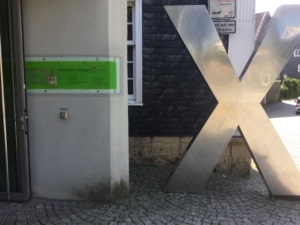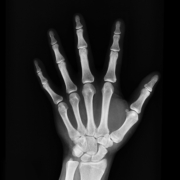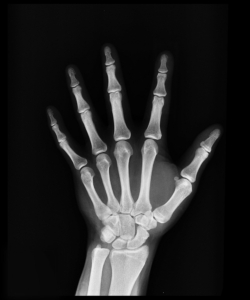Röntgen, Roentgen & X-Rays, or should they be called Lenard Rays?
Article by Dr Fred Starr PhD, FIMMM, FIE, MIMechE, CEng
Professor Röntgen’s discovery of X-rays, and the formation of the British National Health Service changed my life. Although it took another fortuitous discovery, almost forty years later, for me to understand why, and what had happened to me as a very young infant.
Who discovered X-Rays?
But first, let’s get back to the history of X-Rays and the peculiar title of this piece. There cannot be one German citizen who hasn’t had a Röntgendiagnostik and knows what it is about. Over here, it’s same with X-Rays, although not one in ten thousand would connect the name Wilhelm Conrad Röntgen (or Roentgen as we tend to spell it in Britain) with the discovery. A discovery which not only revolutionised medical practice, but told us that there are just 92 naturally occurring elements, and transformed my own subject, the high temperature corrosion of metals.
There is something of a shaggy dog story to what I found about the discovery, and why one might suggest that another German scientist, Philipp Eduard Anton von Lenard, should get more credit than usually acknowledged. Rontgen is commonly thought to have discovered X-rays by accident. This is just not true. But he was lucky. He just happened to be using a sheet of paper that had been saturated with barium platinocyanide, that turned out to be one of the best detectors for X-Rays. And it just happened to be lying around, waiting to fluoresce when the X-rays struck.
Now to misquote the line from “Back to the Future” where Dr Emmett Brown says to Marty McFly……“I’m sure in 2022 barium platinocyanide paper is in every corner drug store, but here in 1895, it’s a little hard to come by!” How, indeed, was Röntgen using such a peculiar material?
We need to go back to the last decade of the nineteenth century when German Science was beginning to lead to the world. Using the ideas of the Scottish physicist and mathematician, James Clark Maxwell, which, in this country, had been rejected for their obscurity, Heinrich Hertz had discovered radio waves. As predicted by Clark Maxwell, and as measured by Hertz, these can be regarded as light waves with an extremely long wavelength. Part of the electromagnetic spectrum, as scientists like to say.
Having exhausted the research possibilities of radio waves, Hertz turned his attention to a new and different source of waves which seem to be coming from vacuum tubes, through which a current of electricity was being forced. These investigations were at the cutting edge of science, and being cheap to do, there was a huge amount of interest. When activated, the tubes glowed with a mysterious light, and giving forth some kind of emanation. On the one hand there was evidence that the emanation consisted of particles, on the other, it seemed it was an undiscovered variant of ultra violet light. The invisible light that gives a sun tan.
Von Lenard was helping Hertz with his investigations, using a kind of photographic paper coated with “Ketone”, otherwise known as pentadecylparatolylketone, which was found to darken under the effect of the emanations. Here is where Röntgen gets into the picture. He too wanted to be on board the latest science bandwagon, contacting von Lenard about what was going on.
Von Lenard was more than helpful, giving Röntgen a state-of-the-art cathode ray tube and telling him about the ketone coated paper. However, it seems that pentadecylparatolylketone was also not that common at the 1895 drug store, too! Röntgen, being the person he was, started work, using what he had to hand, this being barium platinocyanide paper, which fluoresced when illuminated by ultraviolet light.
The vacuum tube that Röntgen was using was giving off visible light. And quite likely “normal ultraviolet”. To stop theses rays spoiling any tests Röntgen wrapped the tube in black paper. He then noticed that the sheet barium platinocyanide paper, which was some distance off, was glowing. It wouldn’t have taken him very long to find out that the sheet reacted instantly to when the vacuum tube was on or off. And that various objects like house keys and coins made shadows on the screen. But the most amazing observation was the shadowgraph of the bones of his hand.
The discovery of X-rays was made on 8th November 1895. Rather than let von Lenard know what was going on, Röntgen spent the next few weeks in his lab before announcing this amazing discovery at a meeting of the Würzburg Physical and Medical Society on the 23rd January 1896. The highlight of the lecture showed how X-rays could produce a shadowgraph of the hand of Professor Kȍlliker, the grand old man at the proceedings. Once the initial incredulity had disappeared, the use of X-rays for medical and plain amusement spread across Europe and the USA. Within two years it was being used by French Customs to inspect baggage! Röntgen’s fame was assured.
Not the best of friends
Gore Vidal, author, critic, and scriptwriter said about himself, “Whenever a friend succeeds, a little something in me dies”. One can imagine the reaction of von Lenard when he heard the news. Hate for Röntgen was not a strong enough word, which von Lenard matured over the years. Especially when we are informed on good authority that Lenard’s mechanic had told him, “Professor, I left the camera out near the cathode, and as we opened it, it was part black, and I saw a key which I left there.” Lenard, instead of recognizing what was going said, “Keep the camera closed and don’t let it lie around.” Subsequently Von Lenard would claim that if Röntgen was the father of X-Rays, he was the mother.
The rift worsened with the advance of modern physics and the chaos in Germany after the Great War. Although Lenard’s experimental work on the photoelectric effect was used by Einstein to give support to quantum mechanics, he refused to accept the validity of the new Physics. Along with relativity, he characterised them as being Jewish science, referring to Röntgen as a crypto-Jew.
Me and my locked shoulder
I have no recollection of the event, but when I was about two or three years old, I fell on my side, hurting my right arm, although there was no obvious injury. After a couple of days of screaming with pain, I was taken to the local doctor. I guess that the examination must have been cursory as I couldn’t bear the arm to be touched. So began several years of being hawked around quacks who recommended my arm being kept in a sling, and medical illiterate consultants who were fixated on tuberculosis. It looked like I would spend the rest of my life with a dangling, useless, appendage. It began to be referred to as “Fred’s Bad Arm”.
Salvation came with the arrival of the National Health Service in 1947, which in those days meant absolutely free medical help. I was given an X-Ray at the local hospital in Stockton-on-Tees. The young doctor explained that he had seen a lot of shoulder injuries similar to mine, from badly wounded servicemen. He had been able to build up their shattered bones, but it wasn’t possible with a young boy like me. The surrounding bones would just keep growing.
The best he could do was to put me through a series of stretching exercises that would give the arm much more freedom. They were very painful, but they worked. I can remember the absolute joy in the family when they saw I was able to lift a soup spoon to my mouth. But even today, I cannot touch the top of my head with my right hand. I still have a bad arm.
I never knew what was wrong with me until going round the Smithsonian Museum in Washington, in 1978, when I was over there for a conference on coal gasification. One of the exhibits was a whole-body X-Ray of an American Indian boy with a dislocated shoulder. The long bone of his upper arm had been pulled out of its socket. My own injury, termed a locked shoulder by the medicos, wasn’t anything like as bad, apparently. But a locked shoulder was, and still is, difficult to rectify. The arm needs to be pushed back almost straight away, but who was going to that to a screaming infant? I wonder how my life might have been altered if I had been put right. Might I have had some interest in sport and athletics? Somehow, I doubt it.
X-Rays, high-temperature corrosion and me
Within just a few years, the very brilliant scientist, Henry Moseley, in England, was finding that the wavelength of the X-Rays coming off each element varied in a quite definite manner. So much so it was possible to show that there were just 92 elements and that some had yet to be discovered. Unlike Röntgen and Von Lenard, who were awarded the Noble Prize for their efforts, Moseley got nothing. He being one of the untold victims of the First World War. Only live scientists are eligible.
By the 1970s, the Moseley discovery was incorporated into the electron probe microscope, which uses electrons, exactly like light to illuminate tiny objects. A side benefit is that the electrons produce X-Rays characteristic of whatever elements are present. This ability was vital in the understanding of what was going on, in my own subject, where we needed to analyse very thin layers of high temperature corrosion scales.
Unfortunately, my own part of British Gas R&D had invested in a transmission electron microscope, which turned out to be an absolute white elephant. Only brought out for display Potemkin style for visitors. I had argued for it to be replaced with an electron probe, without much success, until I found myself in hospital, seriously ill with hepatitis. A very infective disease.
After I had been in isolation for about five weeks, my boss got through the door of my cubicle, asking me to write a memo justifying the need for an electron probe. When I returned to work after five months away, my first job was to write a proper report showing how the probe would benefit our work. This, I did, with the help of the Scientific Instrument Research Association, just outside of London.
Eventually we got our electron probe. But do you know what? I was the only person expressly stopped from using it! I will wonder why until my dying day.
How we remember them
Moseley has no monument as such. But his law is a key feature of Niels Bohr’s model of the atom, and whenever this is explained Moseley will be remembered. Von Lenard is a sad case. Partly through his envy of Röntgen, the death of his son owing to the British blockade of Germany, and his extreme antagonism to the Jews (a feature of much of European and American life, at the time, it should be admitted) he became the most important German Scientist awarding credibility to Hitler. As such Von Lenard’s star waxed in the 1930s. Isaac Asimov in his majestic tome on the lives of all major scientists ends the piece on Von Lenard by saying “He may have regretted his own stupidity in the light of events, or may have been altogether too stupid to do so.” Nevertheless, I feel it is a pity that his contribution to the advance of science, which was more than just X-rays, has been allowed to vanish.
 Röntgen’s name, of course, lives on in Germany and even has two small installations dedicated to him. One, the Deutsches Röntgen-Museum in his birthplace at Lennep near Wuppertal appears to be quite superb. There is also the Röntgen Memorial Site in Würzburg in the Physics Institute where X-Rays were discovered.
Röntgen’s name, of course, lives on in Germany and even has two small installations dedicated to him. One, the Deutsches Röntgen-Museum in his birthplace at Lennep near Wuppertal appears to be quite superb. There is also the Röntgen Memorial Site in Würzburg in the Physics Institute where X-Rays were discovered.
Röntgen’s other contribution to society and life is through his imaginative use of the letter “X”. It has entered soul of Western Civilisation, so we have “X-Men”, films like the “Man from Planet X”, and advanced computers called “X-Machines”. Quite unconsciously, we even have other uses for the letter. So, with failing football managers, crooked businessmen, and lying politicians we hear of “Xplanations” and Xcuses” of the most dubious sort.
Further writings and publications by Fred Starr are available online at FredStarr.com





